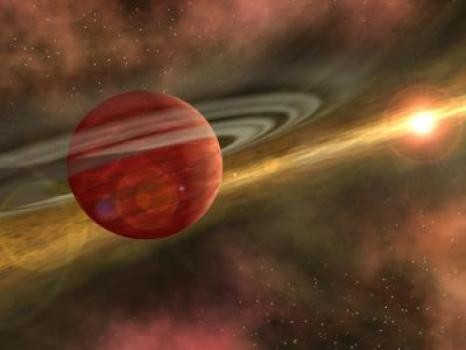Mystery Planet 'That Shouldn't Exist' Baffles Astronomers

A team of astronomers have discovered a mystery planet that should not exist in its outer space location.
Scientists at the University of Arizona found the most distantly orbiting planet with a single, sun-like star to date.
The planet, which is relatively young at just 13 million years old, still glows from the residual heat from its formation, with temperatures reaching about 1,500C.
Named HD 106906 b, the planet weighs 11 times that of Jupiter's mass and is extremely far from its star. Our largest planets, Uranus and Neptune, orbit at between 15 and 30 times the average Earth-Sun distance. In comparison, HD 106906 b, orbits at 650 times the average Earth-Sun distance.
The planet, scientists say, should not exist in its current location as it does not conform to any current theories about how planets come into existence.
Research leader Vanessa Bailey said: "This system is especially fascinating because no model of either planet or star formation fully explains what we see."
Astronomers believe planets close to their stars, like Earth, merge from small asteroids born in primordial dust surrounding a forming star. For giant planets, this process is too slow, so scientists have proposed planets can form from the collapse of the disk material surrounding the baby star. HD 106906 b does not conform to either theory so should not have an orbit so far from its star.
For HD 106906 b, researchers say the planet may have formed through a binary star system.

"A binary star system can be formed when two adjacent clumps of gas collapse more or less independently to form stars, and these stars are close enough to each other to exert a mutual gravitation attraction and bind them together in an orbit," Bailey said.
"It is possible that in the case of the HD 106906 b system the star and planet collapsed independently from clumps of gas, but for some reason the planet's progenitor clump was starved for material and never grew large enough to ignite and become a star."
Baily added, however, that there are problems with this theory as it does not conform to current thinking on mass ratios of binary systems.
The scientists also note that they are still able to detect the remnant "debris disk" of material left over from the young planet and its stars formation.
"Systems like this one, where we have additional information about the environment in which the planet resides, have the potential to help us disentangle the various formation models. Future observations of the planet's orbital motion and the primary star's debris disk may help answer that question."
Observations of the planet using Hubble Telescope Data showed HD 106906 b is moving with its host star, providing information about the planet's nature and composition.
"Every new directly detected planet pushes our understanding of how and where planets can form," said co-investigator Tiffany Meshkat.
"This planet discovery is particularly exciting because it is in orbit so far from its parent star. This leads to many intriguing questions about its formation history and composition. Discoveries like HD 106906 b provide us with a deeper understanding of the diversity of other planetary systems."
© Copyright IBTimes 2025. All rights reserved.






















